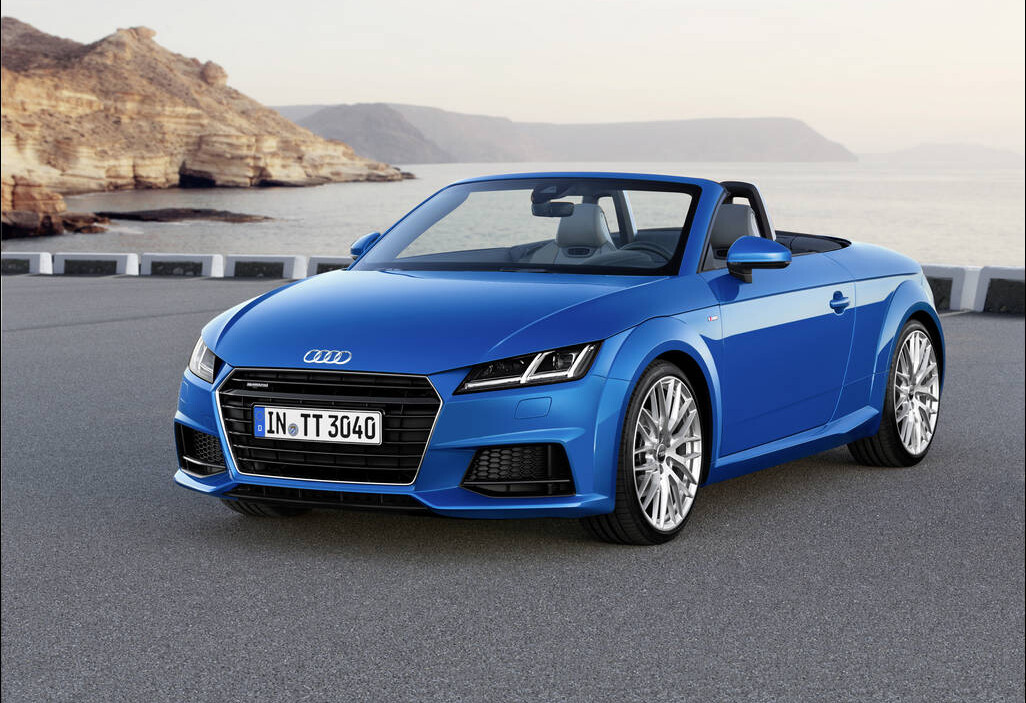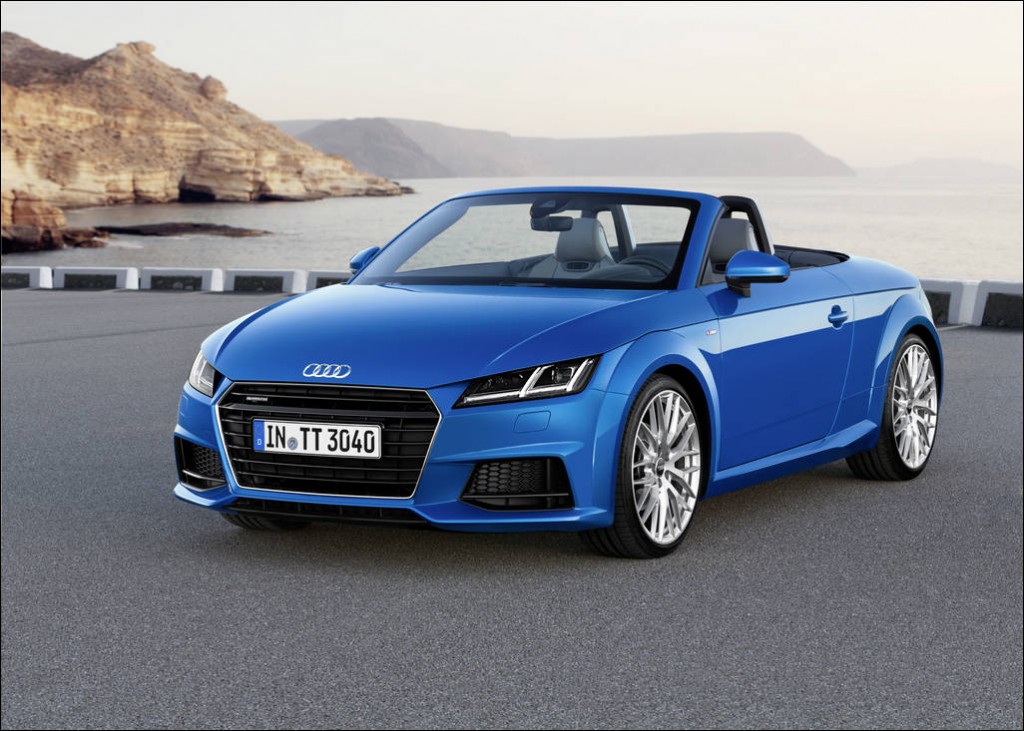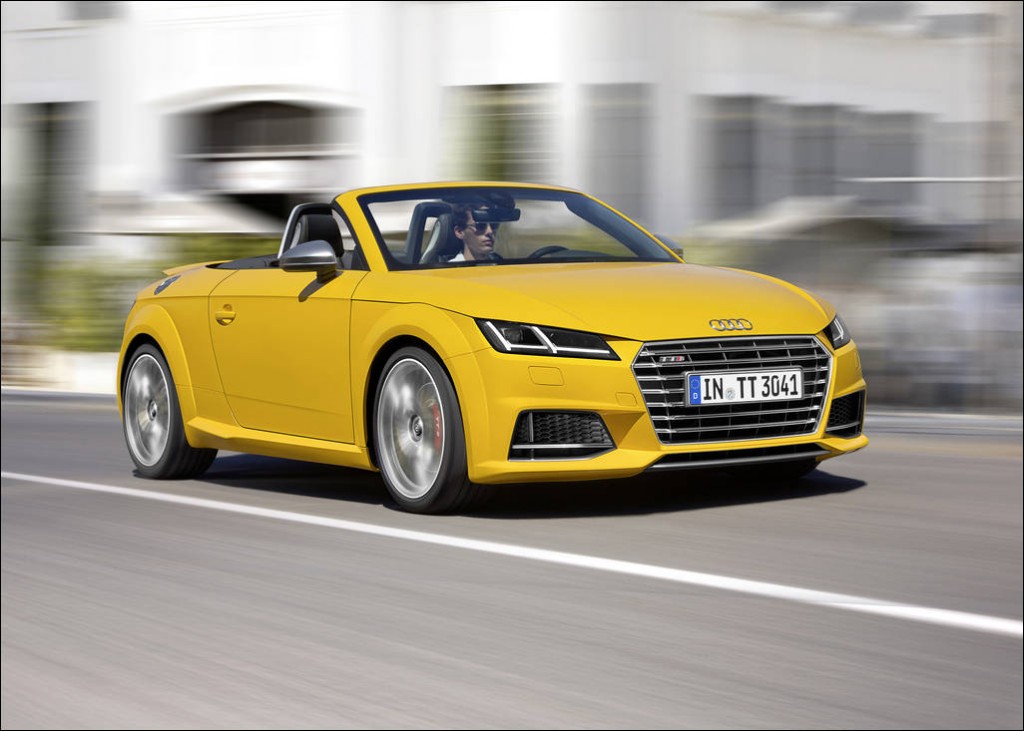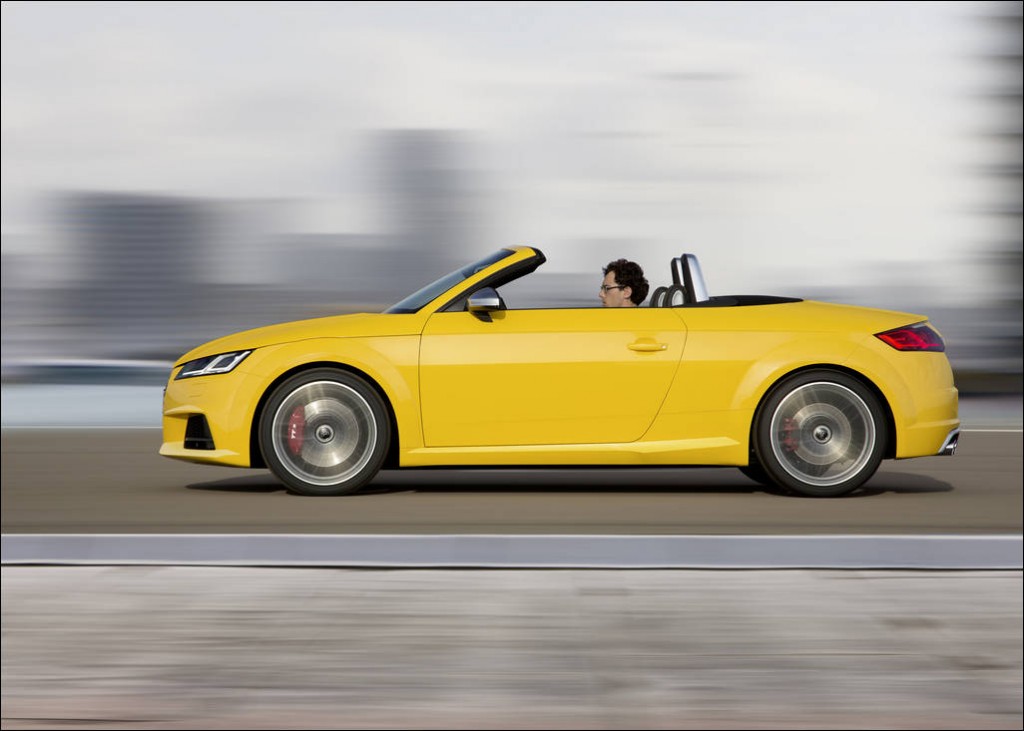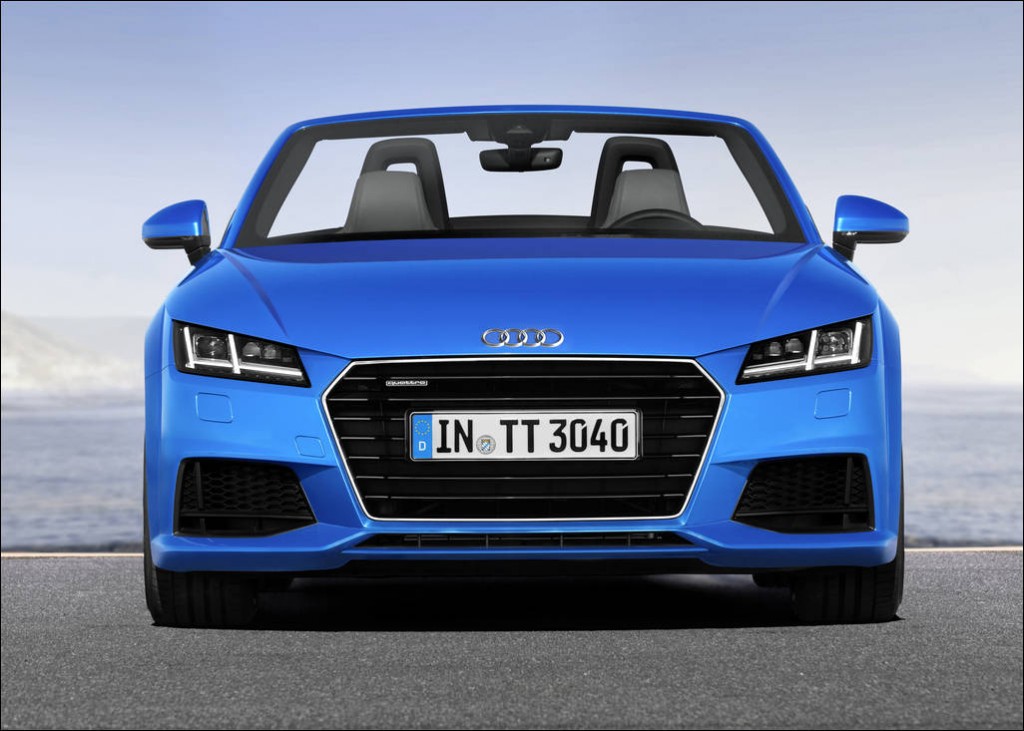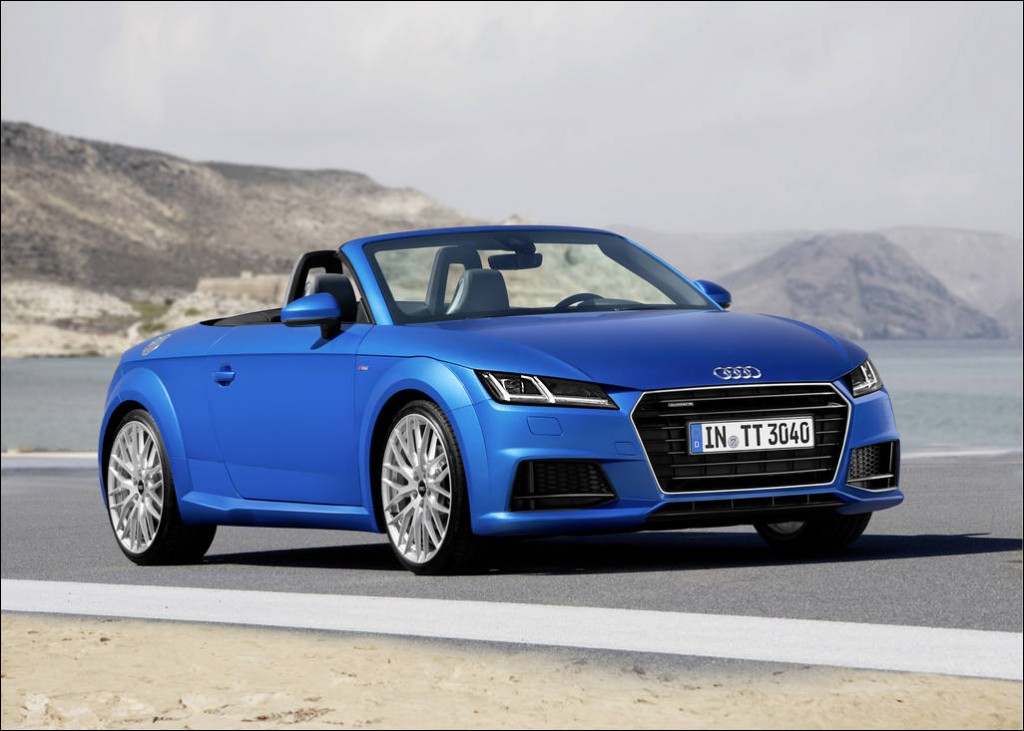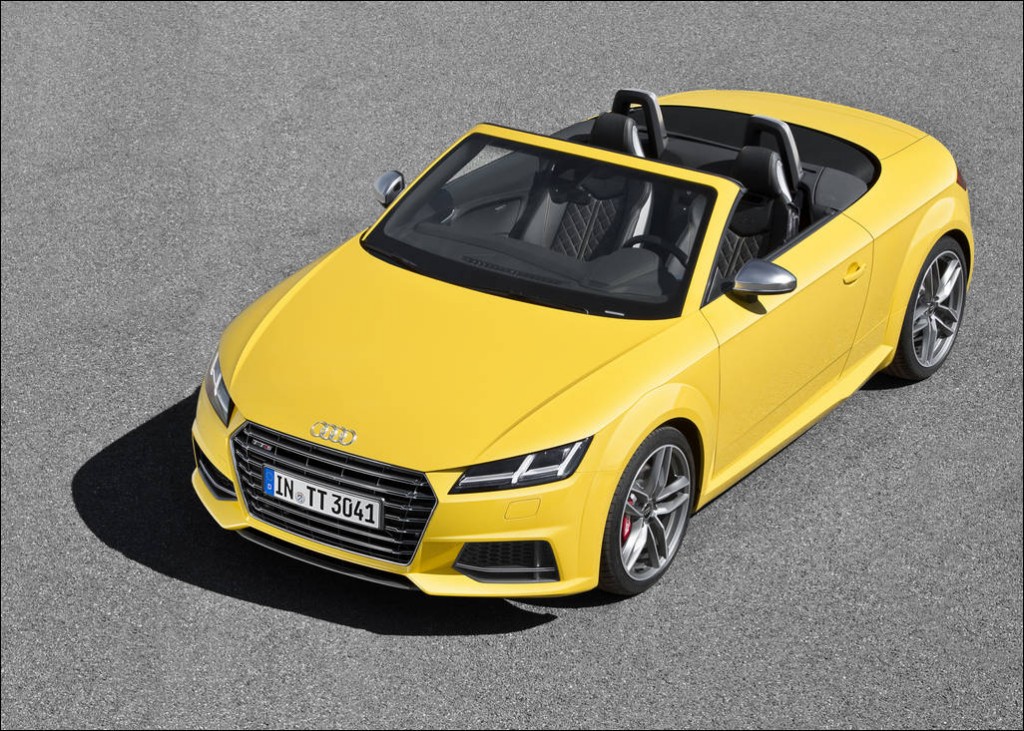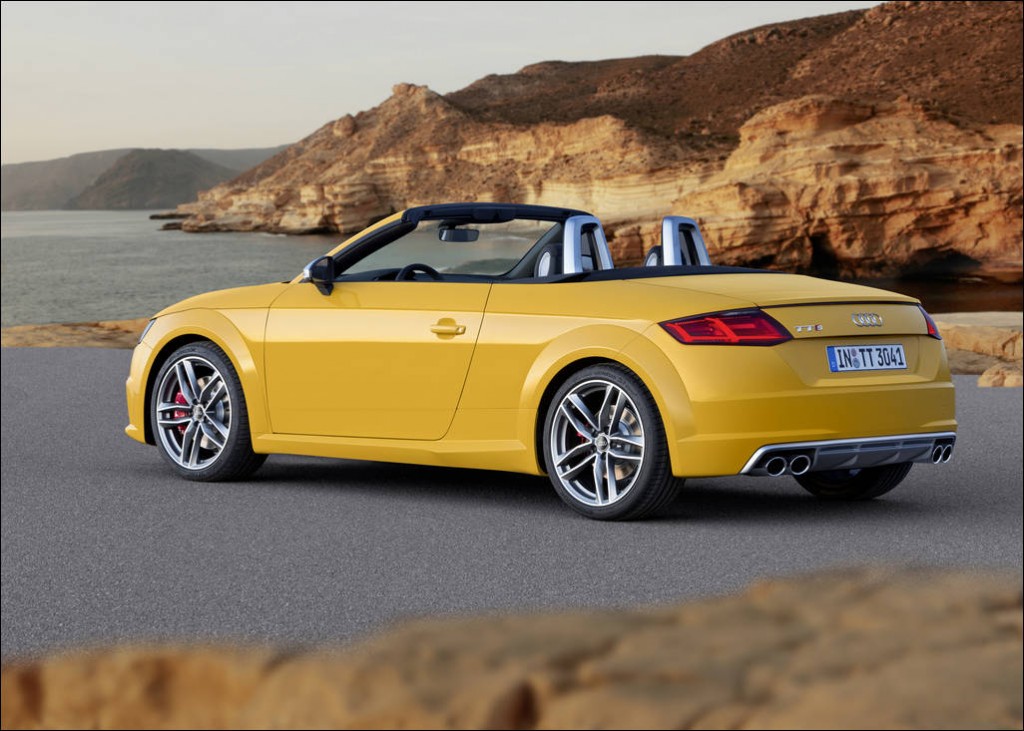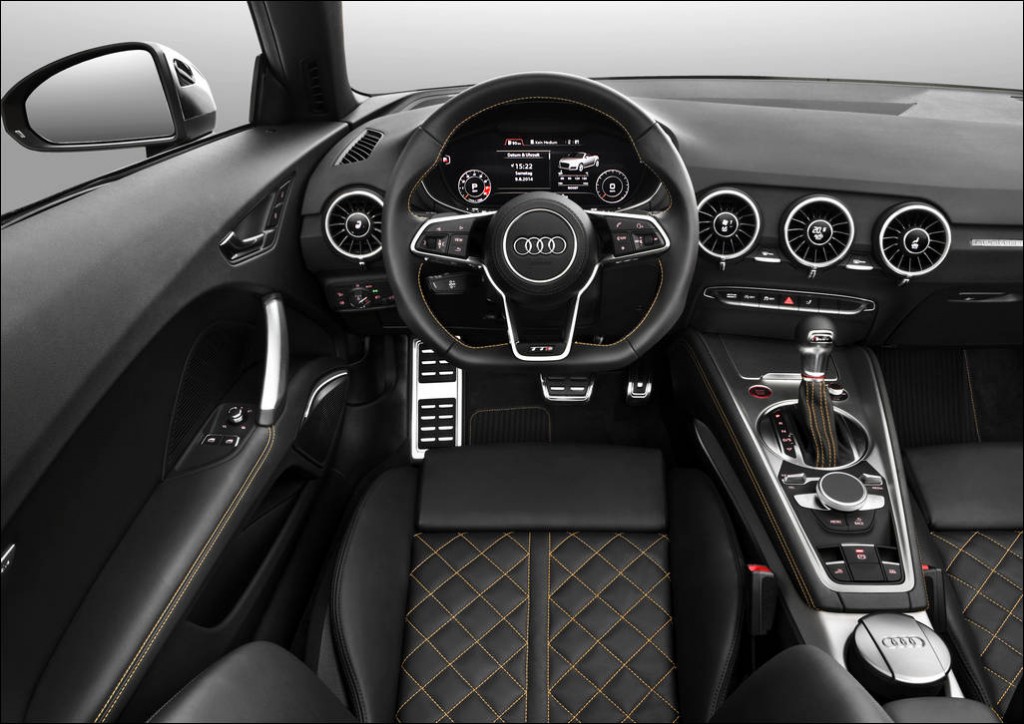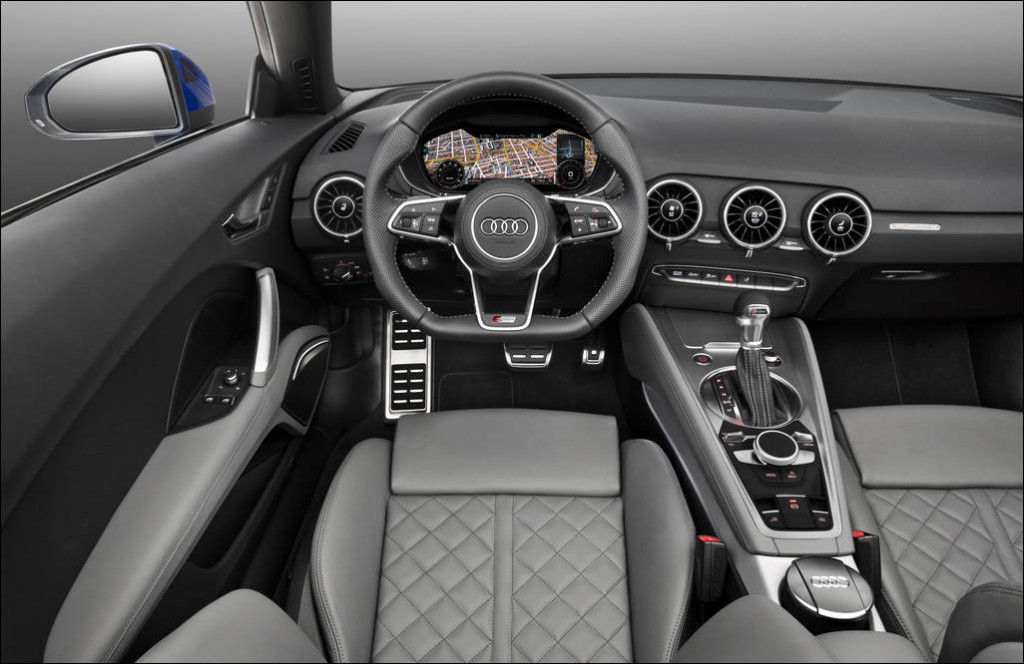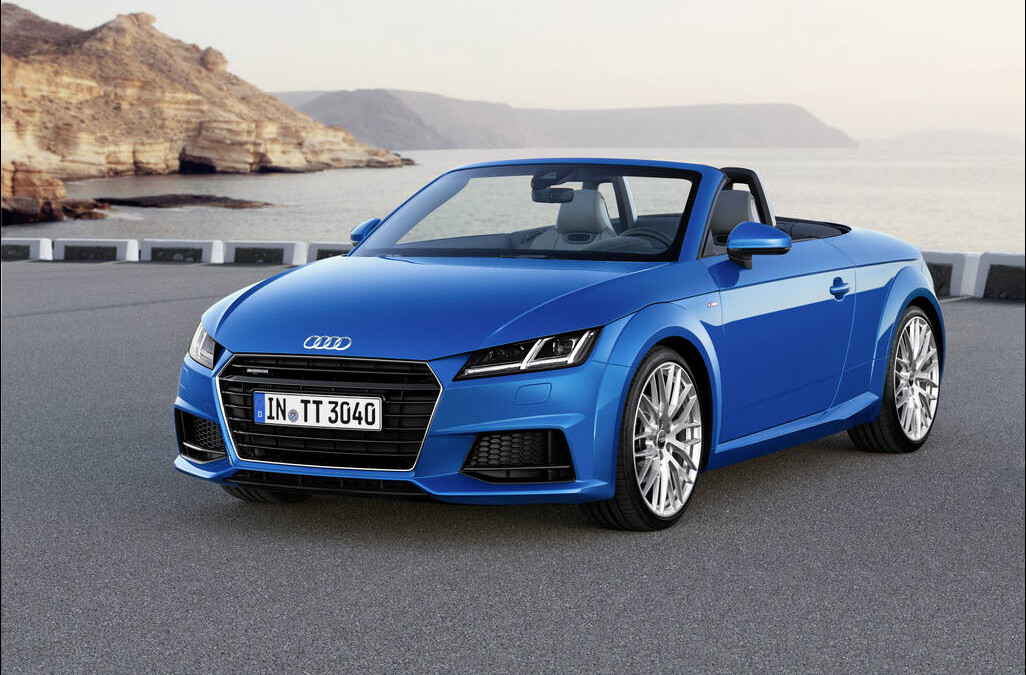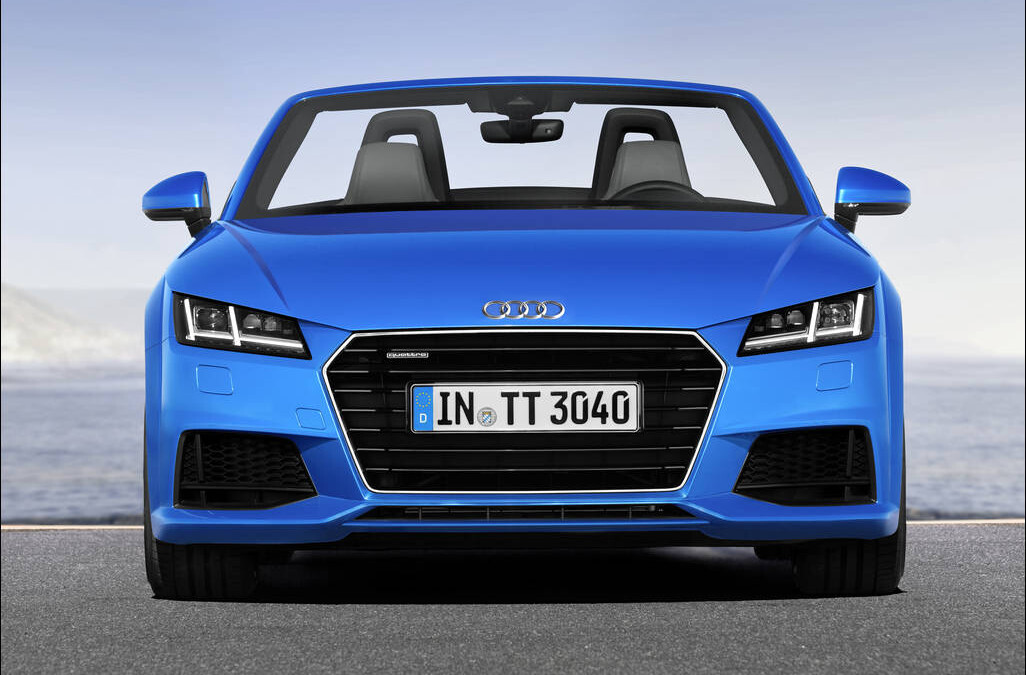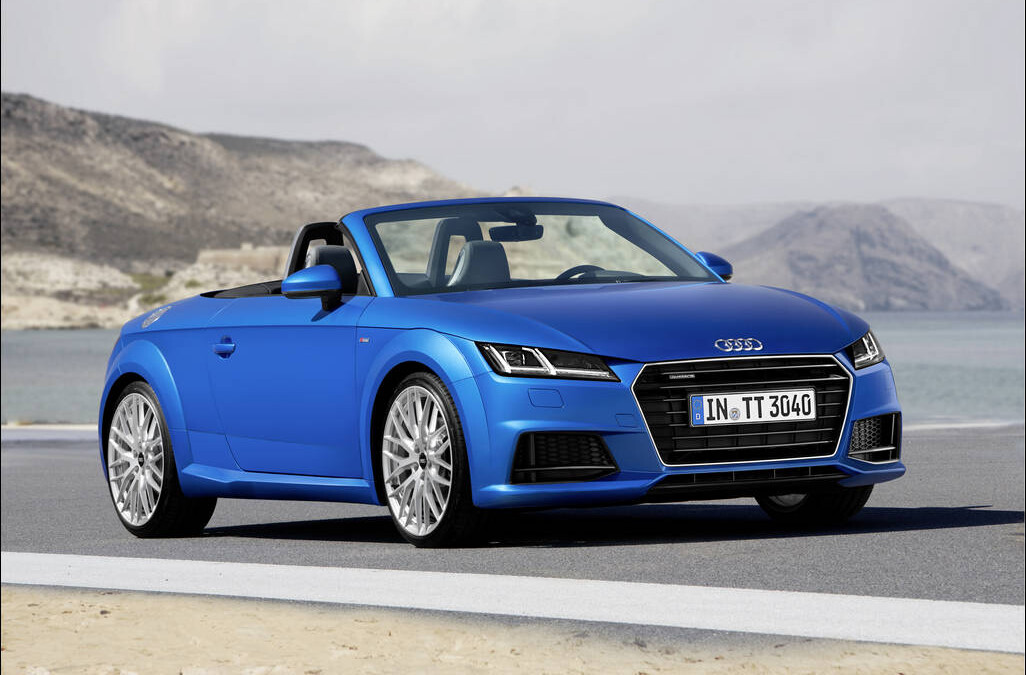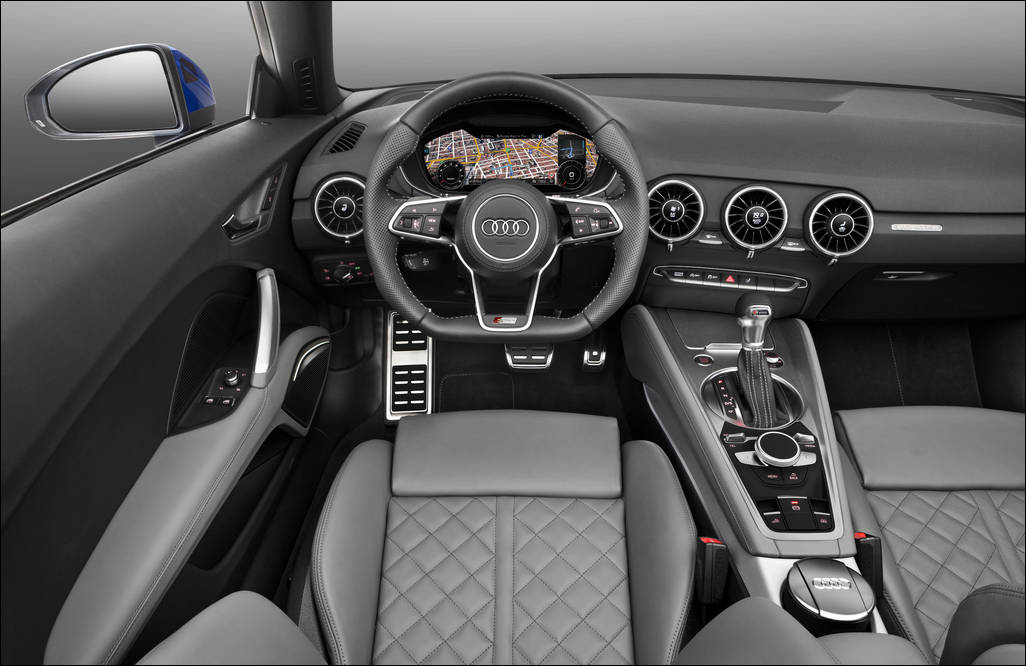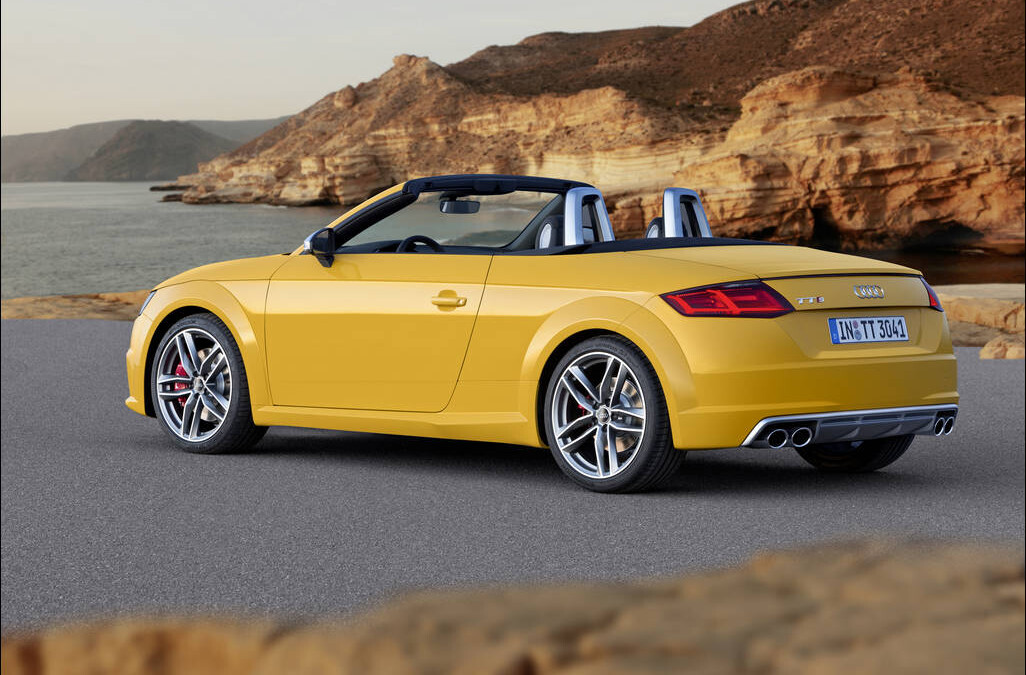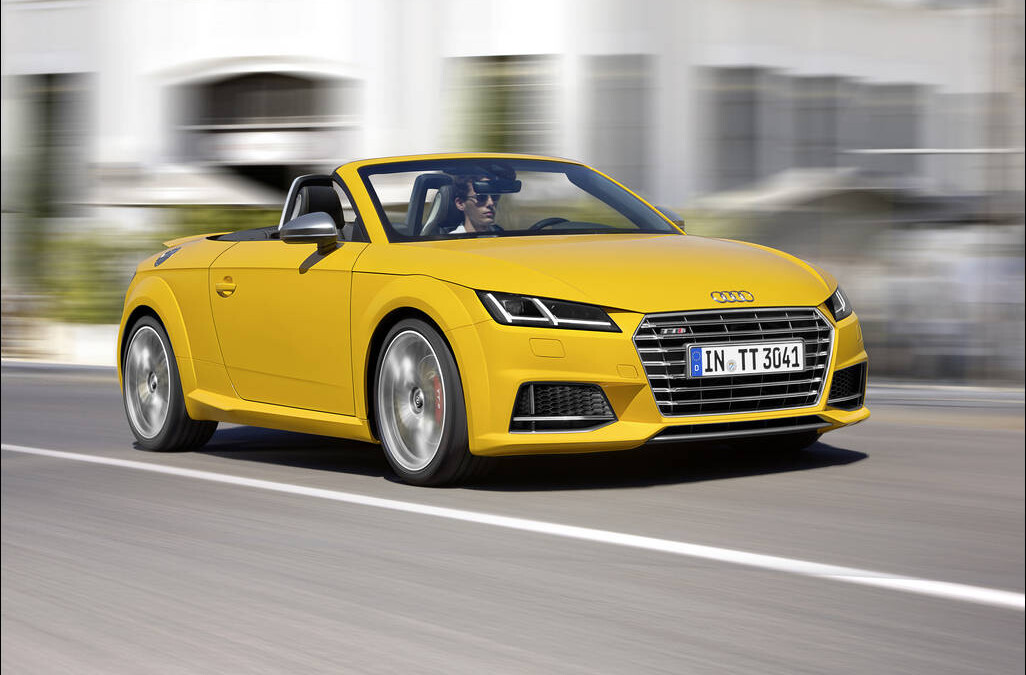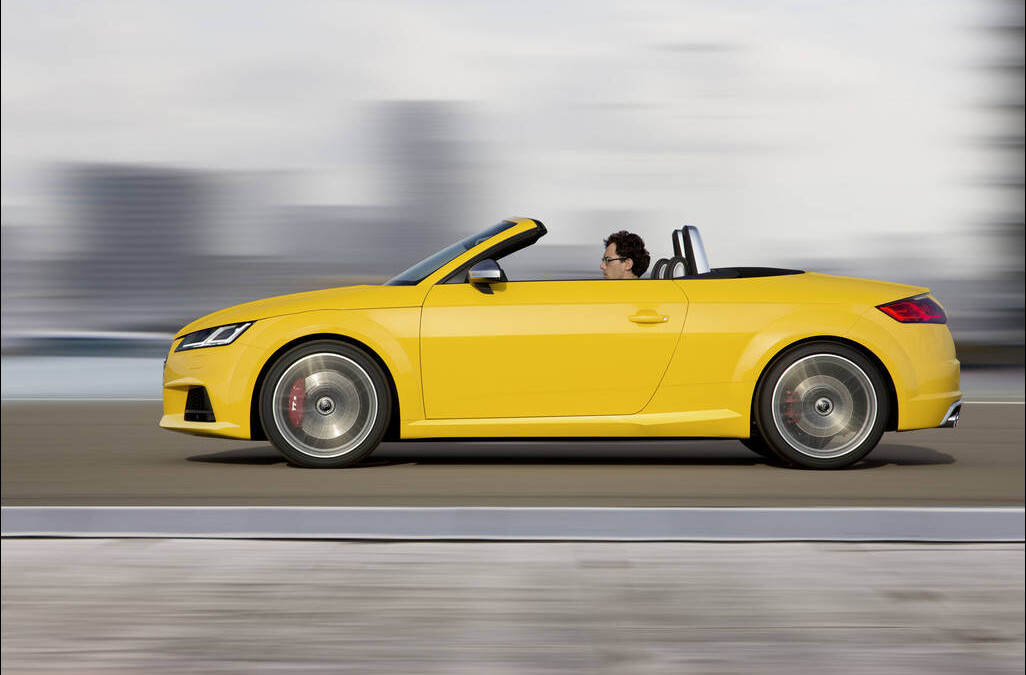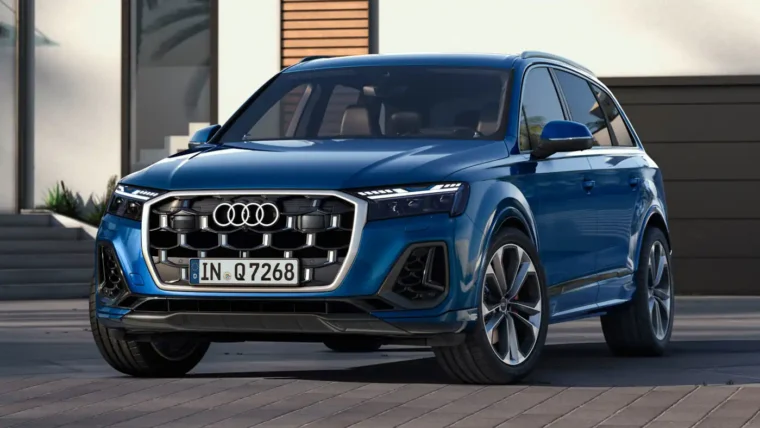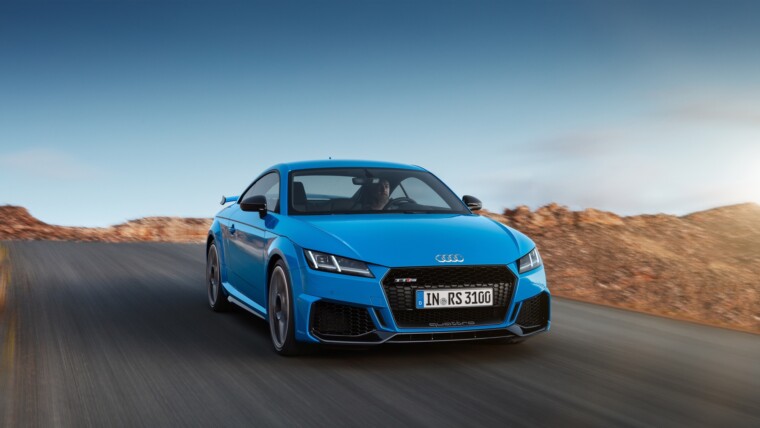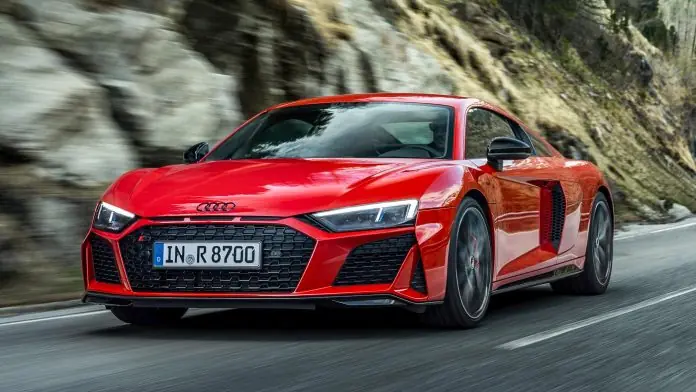Purity in its most beautiful form: Audi is presenting the new TT Roadster* and the TTS Roadster* at the Paris Motor Show. The compact two-seater sets new standards in design, drive, and suspension. A particular highlight in the third TT generation is the Audi virtual cockpit. For the first time, the digital instrument cluster provides all information within the driver’s field of vision – a concept that is causing a sensation. This has already led to the Audi TT’s new display and control system receiving the Car Connectivity Award and the honor of Interior Innovation of the Year at the Automotive Interiors Expo Awards.
“The concept of designing a compact roadster following clear geometrical rules formed the original idea for the Audi TT in autumn 1994,” says Prof. Dr. Ulrich Hackenberg, Board Member for Technical Development at AUDI AG: “From the first generation on, it has been a sports car for the senses – a driving machine with an authentic design. With the new TT Roadster, we have developed this concept in a consistent manner and further improved the technical experience in the car with innovations such as the Audi virtual cockpit.”
A design that is full of character is fused with timeless aesthetics – the third-generation TT Roadster and the TTS Roadster mark the continuation of a great tradition. The Audi designers have reinterpreted the styling of this classic vehicle and complemented it with innovative components.
New from the ground up: the control system
The control system in the new Audi TT Roadster and TTS Roadster is fully focused on the driver. There are two variants of the new multifunction steering wheel available. Thanks to the fundamental redevelopment of the control logic, the reworked MMI terminal features six hard buttons. The natural language control also makes it easier to operate the system when driving.
In combination with the MMI navigation plus, the MMI touch – the touchpad on top of the rotary push-button – is also on board. The driver can use this to scroll through lists, zoom in on maps, and enter characters. The menu structure is inspired by the layout of a smartphone and includes free text search. All key functions can be reached with just a few clicks, and the buttons on the side provide access to intelligently linked functions and options.
Another top innovation in the new TT generation is the Audi virtual cockpit. With its versatile, detailed depictions, the digital instrument cluster replaces the analog instruments and the MMI monitor. It is possible to toggle between two levels of the 12.3‑inch display. The classic view is dominated by the tachograph and the rev counter, whereas “infotainment” mode focuses on themes such as the navigation map. The TTS Roadster features a third, particularly sporty view that focuses on the rev counter as an important racing instrument.
A further highlight of the new model generation is the voice control, which has been made significantly easier. The system now understands phrasings from everyday language, meaning that hundreds of command variations are possible for each function. In the telephone menu, for example, calling a contact is as easy as saying “I want to talk to Peter” or “Connect me to Peter.” The natural language control is also integrated into the navigation, radio, and media menu items, providing customers with consistent language control.
The fun of open top driving: the concept
The new TT Roadster combines the dynamic ride of a sports car with the driving experience of an open‑top two‑seater. The basis for this consists of struts in the underbody and body that considerably improve both the torsional rigidity and the ride comfort.
The new TT Roadster is sporty, compact and low-slung stance on the road. At 4,177 millimeters, the two‑seater is 21 millimeters shorter than its predecessor. The wheelbase, on the other hand, has grown by 37 millimeters to 2,505 millimeters. The overhangs are correspondingly short. Featuring a width of 1,832 millimeters, the new TT Roadster is 10 millimeters narrower than its predecessor and has a height of 1,355 millimeters (3 millimeters less). Its drag coefficient is only 0.30 with the top closed – number one in the compact sports car segment. This is down to Audi having combined the distinctive design with excellent aerodynamics.
The front of the open‑top sports car conveys power and energy through its accentuated horizontal lines. Similar to the Audi R8*, the Singleframe grille is wide and flat – the four rings are positioned on the hood in the style of a high-performance sports car. On the standard version, the air inlets are connected to one another and divided by two vertical slats.
Two vertical lighting elements are also positioned in the headlights and emit the daytime running lights. Audi optionally supplies the headlights in LED technology. The headlights will also be available in the new Matrix LED technology shortly after the market launch – in this case, the high beam is produced by small, individually controlled light emitting diodes. In the Matrix LED headlights, the indicator featuring a dynamized display – another brand innovation – runs in the direction selected by the driver.
The flat and taut top of the new TT Roadster and the TTS Roadster also provides a clear contrast with the body and is defined by the short side window design that is typical of the TT Roadster. When viewed from the side, many of the details invoke the first generation of the design classic. The shoulders have a muscular look and the sill contour forms a strong light-refracting edge. The broad wheel arches form their own geometric entities: The front wheel arch breaks through the hood gap that continues as the tornado line all the way to the rear end. The driver no longer needs to unscrew the cap underneath the classic round tank flap on the right side. Direct refueling is performed in true racing style.
At the rear, horizontal lines again underscore the width of the open‑top sports car. The bars in the standard LED rear lights, which adopt the motif of the headlights, are permanently illuminated. The third brake light – a flat strip on the edge of the luggage compartment lid – connects the light silhouette at the rear. A diffuser incorporates the tailpipes of the exhaust system. At speeds of 120 km/h and above, a spoiler is electrically extended from the luggage compartment lid to provide additional downforce on the rear axle.
Light and quiet: the convertible top
As with all Audi Cabriolet models, the new TT Roadster and the TTS Roadster also feature an electrically actuated fabric top. This is available as standard in black, titanium gray and jive, and fits perfectly into the design line. With parts made from magnesium, aluminum, steel and plastic, the soft top weighs just 39 kilograms and is 3 kilograms lighter than its predecessor. This has a positive impact on the gross vehicle weight and the center of gravity of the open‑top two seater.
While opening, the top forms a Z shape as it folds together into a flat package. When is stowed in the aluminum tray, it does not encroach on the 280‑liter luggage compartment. The electric drive with the two electric motors performs opening and closing in 10 seconds, even when driving at speeds of up to around 50 km/h. As a result of the elaborate clamping technology, the closed top is completely taut even at high speeds – it features a homogeneous look that conceals the cross bows.
The acoustic top is already fitted as standard on the Audi TT Roadster and Audi TTS Roadster and is noted for its extremely good thermal insulation and a low noise level, especially in the frequency range of the airflow. The thick fleece layer on the black inner headlining adds comfort. Depending on frequency, the noise level in the interior has been reduced by up to 6 dB compared with the predecessor. The aerials for radio reception are hidden from view by the convertible top. An electric mesh wind deflector and the S sport seats including headroom heating are optionally available.
Intelligent composite construction: the body
The body of the TT Roadster and the TTS Roadster represents a new evolution of the Audi Space Frame (ASF) based on the modular transverse matrix (MQB). Ultra-high-strength components made from hot-shaped steel reinforce the front section and the passenger compartment floor. The passenger compartment and all outer skin and attachment parts are made of the classic semi-finished aluminum products cast node, extruded profile and sheet metal.
With the 2.0 TFSI and manual transmission, the unladen weight of the TT Roadster (without driver) is only 1,320 kilograms. The Audi engineers have also further improved the crash safety through the intelligent composite concept in the TT Roadster.
Compared with the Coupé, the body of the Roadster has been modified in important areas. The aluminum A‑pillars each conceal a second steel pillar in their interior, which in turn houses a solid steel tube. Internal steel ribbing ensures the aluminum sills have high-strength properties. V‑shaped steel struts reinforce the zones underneath the engine compartment and the luggage compartment, and connect the axle carriers.
In the TT Roadster and the TTS Roadster, a solid wall consisting of two box profiles separates the interior from the luggage compartment, and replaces the bottom cross member found on the Coupé. The upper area of this wall houses the steel roll-over bars, whose elegantly rounded form marks another classic design theme. Mounting plates seal the openings in the rear wall, which features through-loading as standard.
Powerful and efficient: the engines
The new TT Roadster is being launched with two turbocharged four-cylinder engines, a TDI and a TFSI. A powerful TFSI ensures efficient drive in the TTS Roadster. With power outputs between 184 hp and 310 hp, they clearly surpass the respective predecessor engines in terms of power, while significantly undercutting them with regard to consumption.
Using the modular transverse matrix, all engines are mounted in the same place – their installation location has great advantages with regard to packaging. A start‑stop system is included as standard. In combination with the optional driving dynamics system Audi drive select (fitted as standard on the TTS Roadster), the adjustable engine sound makes the sound even more sonorous.
Featuring 184 hp and 380 Nm of torque, the 2.0 TDI ultra is already a sporty engine. As with all engines in the new TT family, the two‑liter diesel engine meets the Euro 6 standard. It averages just 4.3 liters of fuel per 100 kilometers, which equates to CO2 emissions of 114 grams of CO2 emissions per kilometer – a new best figure in its segment.
The 2.0 TFSI produces 230 hp and 370 Nm of torque in the TT Roadster; in the TTS Roadster, these figures are as high as 310 hp and 380 Nm. The top model breaks into the high-performance range, sprinting from 0 to 100 km/h in 4.9 seconds on its way to an electronically governed top speed of 250 km/h. The switchable flaps in the exhaust system underscore the sporty sound.
The 2.0 TFSI channels its output to a manual six‑speed transmission; the output can optionally be channeled to a six‑speed S tronic. The dual-clutch transmission shifts rapidly through the gears without any noticeable break in propulsive power and can be controlled by paddles on the steering wheel if desired. In efficiency mode in the Audi drive select system, the S tronic coasts when the driver takes their foot off the gas.
New technology: quattro permanent all-wheel drive
The quattro permanent all-wheel drive has been fully redeveloped; it is optionally available in combination with the 2.0 TFSI engine in the TT Roadster and is fitted as standard on the TTS Roadster. During regular driving, its electro hydraulic multi-plate clutch optimally distributes the drive torque between the front and rear axle depending on driving conditions, road characteristics and driver type.
Driving enjoyment and safety are combined at a new level by electronic clutch management. More power is routed to the rear axle during sporty driving, literally propelling the new TT Roadster and the TTS Roadster into corners. Safe, controlled drifts are possible on low-friction surfaces.
The third TT generation is the first in which the permanent all‑wheel drive is integrated into the dynamic handling system Audi drive select. The driver can use this to toggle the engine characteristics and the operation of the steering support between the comfort, auto, dynamic, efficiency and individual modes. Audi drive select also accesses a series of optional technical modules including the adaptive damper control Audi magnetic ride (fitted as standard on the TTS Roadster) and the six-speed S tronic.
A synthetic hydrocarbon oil containing microscopically small magnetic particles circulates within the damper pistons. Each of the front dampers contains 154 milliliters (6.1 in), the rear dampers 185 milliliters (7.3 in) apiece. When a voltage is applied to a coil, a magnetic field is generated in which the alignment of the particles changes so that they are perpendicular to the oil flow, thereby inhibiting its flow through the shock absorber channels.
The control unit continuously analyzes the driving properties and the condition of the road. Depending on the setting in Audi drive select, the ride of the new Audi TT Roadster and the TTS Roadster is either relatively comfortable, balanced or decidedly taut. The dynamic mode unveils its full dynamic potential. The targeted bracing of the individual wheels during fast cornering ties the Roadster tightly to the road. It largely suppresses roll and makes steering response even more spontaneous. Audi magnetic ride reduces body pitch during braking.
Sporty and stable: the chassis
The McPherson principle is used for the front suspension of the new Audi TT Roadster and the TTS Roadster. Aluminum components reduce the weight of the unsprung masses. The steering rack of the standard progressive steering is designed so that the steering ratio becomes increasingly direct when turning. The rear axle, which features four steel links per wheel, can handle the longitudinal and transverse forces separately.
Together with the progressive steering, the sophisticated suspension and the taut tuning lead to high-precision dynamic handling. The body is lowered by 10 millimeters (0.4 in) on the TTS Roadster, in conjunction with the S line sports package and with Audi magnetic ride. The TT Roadster 2.0 TFSI and the TT Roadster 2.0 TDI roll on 17‑inch lightweight wheels, each of which weighs only 8.7 kilograms (19.2 lb); the tire dimension is 225/50. On the TTS Roadster, the format is 18 inch and the tire size 245/40; the available options range up to 20‑inch format. The newly developed tires are noted for their improved performance together with significant optimization of rolling resistance.
Brakes that can be precisely metered and convey a taut pedal feel are located behind the large wheels. The vented front discs have a diameter between 312 and 338 millimeters (12.3 – 13.3 in) depending on the engine version. The TTS Roadster features newly developed, particularly lightweight aluminum fixed-caliper brakes on the front axle. Another innovation, the electromechanical parking brake, takes effect at the rear wheels regardless of engine version.
The Electronic Stabilization Control (ESC), which can be switched off either partly or completely, perfectly complements the car’s sporty handling. Wheel-selective torque control takes effect when cornering: Where necessary, it can distribute the drive torque from the front wheel on the inside of the curve to the front wheel on the outside of the curve (in the case of front‑wheel drive). With quattro drive, this is also performed at the rear wheel. The car turns very easily into the curve thanks to the difference in propulsive forces, which is helpful for the driver. This enables more precise and neutral driving around curves, with the TT Roadster realizing a major boost in terms of dynamics and stability. Sports mode facilitates particularly sporty driving, facilitating steering and control when drifting.
New line: the interior design
The two-seat interior of the new TT Roadster and the new TTS Roadster fits around the driver like a custom-made suit. It has an intimate and protective feel, particularly when the fabric top is closed, without ever being restrictive. The curb clearance is high and the newly developed sport seats with integrated head restraints are mounted low. Together, they weigh five kilograms less than the seats in the predecessor. The S sport seats are optionally available (standard in the TTS Roadster) and feature particularly powerful, pneumatically adjustable bolsters.
With its light, almost floating lines, the interior continues the line of the exterior. The interior’s central concept is focus on the driver. All controls are grouped around the driver – a statement in favor of sporty, dynamic driving. The door trims and the center tunnel console feature flowing forms that correspond with one another.
When viewed from above, the sleek instrument panel resembles the wing of an airplane; the round air vents – a further traditional TT feature – are reminiscent of jet engines. They conceal the operation of the air conditioning and the optional deluxe automatic air conditioning. The high-precision air vents are an example of the high standards to which the Audi aspires with respect to the function, design, and workmanship of the entire interior.
High quality: color and trim
The new Audi TT offers a far more distinct and varied range of colors than its predecessor. There are 11 exterior colors, one of which is exclusively for the S line. Seven of the colors in the palette are new for the TT, and two of these are completely new for Audi: nano gray and tango red. Panther black, crystal effect and the expressive Sepang blue are also available for the TTS.
There is also a new palette of colors for the interior. There are three interior colors to choose from for both the TT and the TTS. Besides black, these are rock gray and palomino brown. For the first time, customers can choose a second color – rotor gray – in combination with the S line package, naturally also with sporty contrasting stitching. TTS buyers can also choose the sporty leather shade express red.
The equipment for the new TTS includes extended interior elements that add individually selectable color accents to the trims of the S sport seats, the sides of the center console and the rings of the air vents. Audi offers customers with exquisite taste numerous options for customization. Upholstery in various grades of cloth, Alcantara and leather is available for the seats; there are also three leather packages. The S sport seats have characteristic diamond patterning on the high quality fine Nappa leather in the center panel.
The design selection admiral blue is a particular highlight, making an impression with matching leather colors, alternately contrasting stitching, dark aluminum, a coordinated paint finish and a special mesh floor mat.
For the TTS, Audi’s design engineers have developed an innovative technical laser texture for the wings of the dashboard. This texture has a honeycomb-like, slightly raised structure that gives the TTS an unrivaled sporty appeal.
Convenient: the equipment
In Germany, sales of the new TT Roadster will begin with the Paris exhibition in October 2014; the TTS Roadster will follow at the start of 2015. The basic price of the 2.0 TFSI is €37,900. The generous standard equipment, which includes xenon plus headlights, air conditioning, and the MMI radio, can be expanded with numerous pieces of sporty, practical, and convenient optional equipment.
The optional driver assistance systems are also cutting edge. The Audi side assist included as standard in the 2.0 TFSI and TTS ensures safe lane changes with a radar measurement towards the rear, and the Audi active lane assist keeps the open top two seater in its lane with minor steering interventions. The park assist with display of surroundings automatically controls the car into and out of parking spaces. Traffic sign recognition is another optional system; attention assist is provided as standard.
Topping the modular infotainment program is MMI navigation plus with MMI touch. It already uses the second generation modular infotainment program with the Tegra 30 graphics processor from Audi’s partner Nvidia. It goes without saying that the Audi TT features the high speed communication standard LTE (Long Term Evolution) on board. The supplementary module Audi connect additionally features the familiar tailored online services – from Google Earth and Google Street View through to Twitter and Facebook access. Another new feature is online media streaming. The MMI connect app enables access to services such as Aupeo! and Napster.
With the Audi phone box, the cell phone can be conveniently docked in the car and the seat belt microphone ensures excellent voice quality during calls even when the convertible top is open. The optional Bang & Olufsen sound system provides 680 watts of power and features 12 loudspeakers. The specially designed frames for the woofers are adorned with anodized aluminum elements bearing the logo of the Danish hi-fi specialists. A white LED light conductor makes the sound system a highlight even at night.
Other posts by AF Newsdesk

